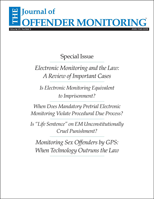Underusing Electronic Monitoring in Scotland
Author: Mike Nellis.
Source: Volume 26, Number 02, Fall/Winter 2013 , pp.10-19(10)

< previous article |next article > |return to table of contents
Abstract:
This is an extensive and fascinating account of the recent history of electronic monitoring in the United Kingdom’s most politically liberal member. Scotland voters defeated a referendum on independence last year, then promptly voted in 56 “Scottish National Party” candidates out of 59 seats in Parliament, and many think that a referendum on independence, if held again, would pass overwhelmingly. In any case, Scotland has a reputation for progressive politics and might seem a logical place for widespread adoption of policies to reduce imprisonment, including the use of electronic monitoring as an alternative sanction. As evident from Nellis’s headline, it has not worked out that way. On the contrary, Scotland’s liberal “welfarist” tradition has influenced its sentencing agencies to eschew surveillance using EM. One of the main reasons for Scotland’s inertia is the deeply ingrained distrust by local justice agencies of central government monitoring schemes that mandate the use of a single private service provider. Now, that attitude may finally be changing. The tangled course of EM in Scotland will be familiar to U.S. readers who have struggled to implement programs against strong headwinds of bureaucratic inertia.Keywords: How Scotland Uses Electronic Monitoring; Restriction of Liberty Orders (RLOs); Home Detention Curfew; Penal Reduction Agenda; Sobriety Bracelets
Affiliations:
1: School of Law University of Strathclyde.